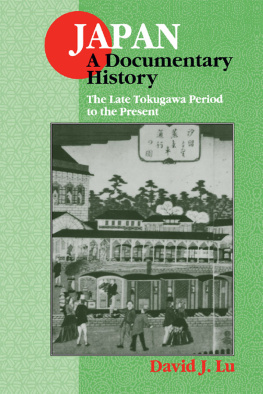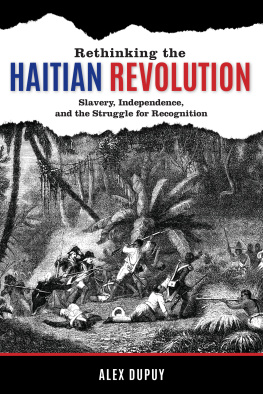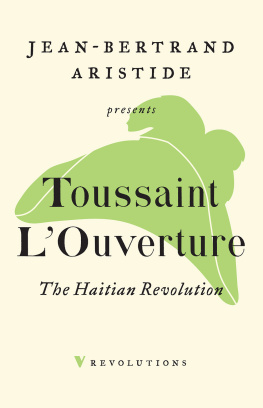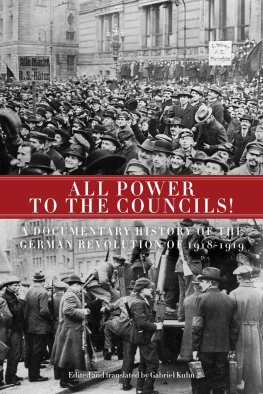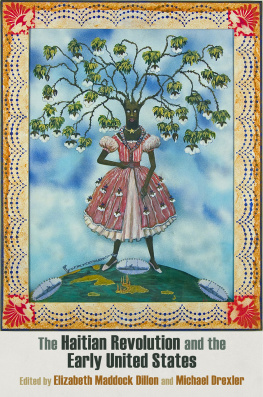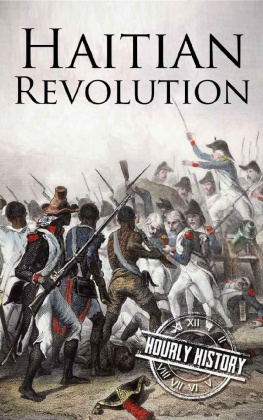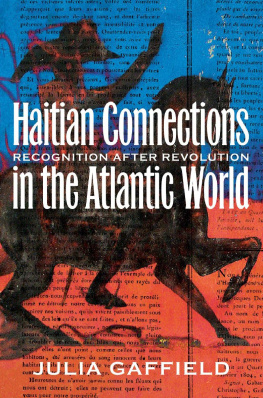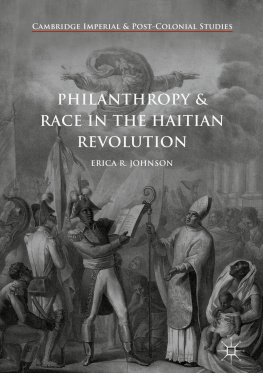David Geggus - The Haitian Revolution: A Documentary History
Here you can read online David Geggus - The Haitian Revolution: A Documentary History full text of the book (entire story) in english for free. Download pdf and epub, get meaning, cover and reviews about this ebook. City: Indianapolis/Cambridge, year: 2014, publisher: Hackett Publishing Company, Inc., genre: History. Description of the work, (preface) as well as reviews are available. Best literature library LitArk.com created for fans of good reading and offers a wide selection of genres:
Romance novel
Science fiction
Adventure
Detective
Science
History
Home and family
Prose
Art
Politics
Computer
Non-fiction
Religion
Business
Children
Humor
Choose a favorite category and find really read worthwhile books. Enjoy immersion in the world of imagination, feel the emotions of the characters or learn something new for yourself, make an fascinating discovery.
- Book:The Haitian Revolution: A Documentary History
- Author:
- Publisher:Hackett Publishing Company, Inc.
- Genre:
- Year:2014
- City:Indianapolis/Cambridge
- Rating:5 / 5
- Favourites:Add to favourites
- Your mark:
- 100
- 1
- 2
- 3
- 4
- 5
The Haitian Revolution: A Documentary History: summary, description and annotation
We offer to read an annotation, description, summary or preface (depends on what the author of the book "The Haitian Revolution: A Documentary History" wrote himself). If you haven't found the necessary information about the book — write in the comments, we will try to find it.
The Haitian Revolution: A Documentary History — read online for free the complete book (whole text) full work
Below is the text of the book, divided by pages. System saving the place of the last page read, allows you to conveniently read the book "The Haitian Revolution: A Documentary History" online for free, without having to search again every time where you left off. Put a bookmark, and you can go to the page where you finished reading at any time.
Font size:
Interval:
Bookmark:
The Haitian Revolution
A Documentary History
The Haitian Revolution
A Documentary History
Edited and Translated, with an Introduction, by
D AVID G EGGUS
Hackett Publishing Company, Inc.
Indianapolis/Cambridge
Copyright 2014 by Hackett Publishing Company, Inc.
All rights reserved
Printed in the United States of America
17 16 15 14 1 2 3 4 5 6 7
For further information, please address
Hackett Publishing Company, Inc. P.O. Box 44937 Indianapolis, Indiana 46244-0937www.hackettpublishing.com
Interior design by Elizabeth L. Wilson
Composition by Aptara, Inc.
Library of Congress Cataloging-in-Publication Data
Geggus, David Patrick.
The Haitian Revolution : a documentary history / edited and translated, with an introduction, by David Geggus. pages cm Includes bibliographical references and index. ISBN 978-0-87220-865-0 (pbk.) ISBN 978-0-87220-866-7 (cloth) 1. HaitiHistoryRevolution, 17911804. 2. HaitiHistoryTo 1791.3. SlaveryHaitiHistory18th century. 4. SlaverySanto DomingoEarly works to 1800. 5. HaitiHistoryRevolution, 17911804Sources. I. Title.
F1923.G338 2014 972.9403dc23 2014006053PRC ISBN: 978-1-62466-179-2
Richard Ligon, A True and Exact History of the Island of Barbados . Edited, with an Introduction, by Karne Ordhal Kupperman.
Alonso de Sandoval, Treatise on Slavery: Selections from De Instauranda Aethiopum Salute . Edited and Translated, with an Introduction, by Nicole von Germeten.
Afro-Latino Voices: Narratives from the Early Modern Ibero-Atlantic World, 15501812 . Edited by Kathryn Joy McKnight and Leo J. Garofalo.
C ONTENTS
The slave uprising that, between 1791 and 1803, transformed the French colony of Saint Domingue into the independent black state of Haiti was by far the largest to occur in the Americas and one of very few to succeed. Saint Domingue became the first major slave-owning society to abolish slavery and the first to outlaw racial discrimination. Haiti was the first modern state in the tropics and the first after the United States to throw off European rule. Of all American struggles for colonial independence, the Haitian Revolution involved the greatest degree of mass mobilization and brought about the greatest social and economic change. In twelve years of desolating warfare one of the most productive colonies of the day was destroyed, its economy ruined, and its ruling class entirely eliminated.
The Haitian Revolution is an event of global significance because of its uniqueness, its precedence in the narratives of antislavery and decolonization, and also because of the importance of the colony where it took place. Although Saint Domingue was no bigger than Maryland or Vermont, it was a powerhouse of the Atlantic economy whose exports exceeded those of the United States and were worth more than those of Brazil and Mexico combined. The revolution reshaped world commodity markets and great power politics while swallowing up armies sent from France, Spain, and Britain. It inspired slave resistance and planter paranoia across the Americas, as well as poetry and novels in several languages. It created a widespread refugee diaspora and powerfully affected arguments about race and the future of slavery.
Saint Domingue on the Eve of Revolution
In the late eighteenth century, Saint Domingue had the Americas strongest export economy. It produced more sugar and coffee than anywhere else, as well as cotton, cacao, and indigo. These were not the cheap bulk commodities they later became but valuable staples, the lifeblood of Atlantic commerce. Saint Domingue was not the wealthiest colony in the world, as sometimes is said; its taxable population and towns were small compared to those of Mexico or Bengal, or Britains North American colonies. Yet it represented the apogee of the European colonizing process begun three centuries earlier, for the purpose of colonies was to export what Europe could not produce. Saint Domingues exports kept an entire navy in business. The French government received substantial revenue from taxing its trade, and the colony also had the best naval base in the Caribbean. It was important to France not just for economic reasons but fiscal and strategic ones as well.
By the late 1780s Saint Domingue had become the single main destination of the Atlantic slave trade. Its enslaved population was almost as large as that of the United States south of the Potomac, with the important difference that more than half had been born in Africa. When the French Revolution broke out, Saint Domingue was home to about 30,000 white colonists, a roughly equal number of free people of color, and almost a half million slaves. European visitors found it materialistic, profane, and fast-living, a place where sexual license and the pursuit of profit ruled, and religion, family, and tradition counted for little (doc. 1). Large landowners, merchants, and judges formed the colonys social elite, but the white community also included numerous plantation employees and urban workers who had crossed the Atlantic hoping to make their fortune. They resented the disdain showed them by their richer neighbors and were envious of their wealth (doc. 2).
The enslaved population was very heterogeneous. Split up between 7,000 plantations, working sunup to sundown six days per week, it was divided not only by location but by differences of culture and class. About one in three adults was born locally and grew up in slavery speaking the local Creole language. From their ranks were chosen most of the domestic servants, artisan craftsmen, and slave drivers who made up the slave elite. Field hands were generally Africans, who had been sold and branded after crossing the Atlantic beneath the deck of a slave ship (doc. 3). On a typical sugar plantation of 200 workers, there might be speakers of a dozen or more different languages, all at different stages of assimilation into colonial society. Long accustomed to growing their own food and marketing the surplus, the creoles tended to be wealthier than the Africans, and more likely to live in families and to have some familiarity with Christianity.
Working conditions varied considerably between different types of plantations. They were at their worst on the lowland sugar estates, where slaves worked all day and part of the night during the grueling harvest season. These estates often belonged to absentee owners and were run by managers whose incentive was to maximize output at whatever cost (doc. 4). One-third of Saint Domingues enslaved inhabitants lived on sugar plantations. A slightly smaller proportion lived on the mountain coffee plantations, where overwork, underfeeding, and infectious disease were less prevalent, although heinous acts of cruelty were no rarer and as likely to go unpunished (doc. 5). With forty to fifty slaves on average, coffee and indigo plantations were considerably smaller than sugar estates, butmuch larger than most U.S. cotton farmsthey still formed mini-communities, where elements of African cultures could be preserved or blended.
Free people of color made up the middle tier of Saint Domingue society. They covered a broad social range from recently freed Africans to rich landowners and tradesmen who were almost indistinguishable from their white counterparts in appearance and culture. They were more numerous than in most Caribbean colonies and notably more wealthy. Most of the men were probably artisan craftsmen or rural smallholders, and most of the women were market traders or white mens mistresses. Saint Domingue was unusual, however, in that a substantial proportion of free people of color were prosperous planters, some of whom were educated in France. Most white colonists were bachelors and many endowed with property the children they had with enslaved women. Such mixed-race offspring also profited from their local knowledge to build up fortunes in the coffee and indigo sectors, which required less initial investment than did sugar.
Next pageFont size:
Interval:
Bookmark:
Similar books «The Haitian Revolution: A Documentary History»
Look at similar books to The Haitian Revolution: A Documentary History. We have selected literature similar in name and meaning in the hope of providing readers with more options to find new, interesting, not yet read works.
Discussion, reviews of the book The Haitian Revolution: A Documentary History and just readers' own opinions. Leave your comments, write what you think about the work, its meaning or the main characters. Specify what exactly you liked and what you didn't like, and why you think so.



